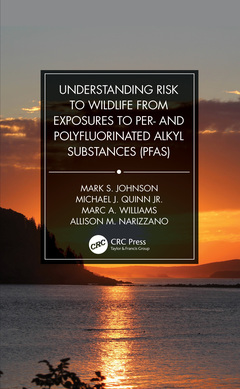Understanding Risk to Wildlife from Exposures to Per- and Polyfluorinated Alkyl Substances (PFAS)
Auteurs : Johnson Mark S., Quinn Jr. Michael J., Williams Marc A., Narizzano Allison M.

Understanding Risk to Wildlife from Exposures to Per- and Polyfluorinated Alkyl Substances (PFAS) provides the most recent summary of toxicity data relevant to mammals, birds, reptiles, and amphibians, and provides values for use in risk assessment applications. Predicting the bioaccumulation of PFAS in terrestrial wildlife (including humans) has proven to be extremely complex. As a group, PFAS act differently than traditional non-ionic organic molecules, where PFAS can break down and reform, whereas some are demonstrated to be extremely persistent. Where sufficient data are provided, this book establishes toxicity reference values (TRVs), which are derived to assist in characterizing environmental sources of contamination and making risk-based decisions.
Features:
- Provides toxicity reference values (TRVs) for vertebrates (mammals, birds, amphibians) for PFAS, where sufficient data are available, and includes objective supporting background information.
- Assigns a level of confidence to each TRV to provide the risk assessor with an understanding of the relative uncertainty associated with each value.
- Presents toxicity data in the formats of scatter diagrams and tables for quick review and assessment.
- Provides TRVs relevant for screening and decision making
This book serves as a useful aid for risk assessors and managers in those industries that have sites contaminated with PFAS, consultants tasked with evaluating risks at such sites, and staff at regulatory agencies at various governmental levels, who need to know how much contamination is considered safe for wildlife. It will also appeal to researchers with an interest in filling the gaps in the current toxicological data for PFAS exposure.
Chapter 1 Introduction
Chapter 2 Perfluorooctanoic acid (PFOA)
Chapter 3 Perfluorooctane Sulfonate (PFOS)
Chapter 4 Perfluorohexane Sulfonate (PFHxS)
Chapter 5 Perfluororoheptanoic Acid (PFHpA)
Chapter 6 Perfluorononanoic Acid (PFNA)
Chapter 7 Perfluorobutane Sulfonate (PFBS)
Chapter 8 6:2 Fluorotelomer Sulfonate (6:2 FTS)
Chapter 9 Perfluorodecanoic Acid (PFDA)
References
Index
Mark S. Johnson, Ph.D., DABT, Fellow ATS
Director, Toxicology, US Army Public Health Center, Aberdeen Proving Ground, MD, USA
Dr. Johnson currently serves as the Director of Toxicology, US Army Public Health Center at Aberdeen Proving Ground, MD where he is responsible for the operational and technical arm of the Army Surgeon General and the Assistant Secretary of the Army for toxicological matters. He has worked extensively in the evaluation of the toxicity of military unique compounds and development and evaluation of a phased approach to the gathering toxicity data for new compounds under development. He has authored over 100 peer-reviewed publications, book chapters, and technical reports and serves on several NATO and EPA panels. He has been a member of Society of Environmental Toxicology and Chemistry (SETAC) since 1997 and is a past Steering Group Member of the Wildlife Toxicology World Interest Group, past chair of Ecological Risk Assessment World Interest Group, and a member of the World Science Committee for SETAC and SETAC North America. Dr. Johnson is also a member of the International Board of Environmental Risk Assessors (IBERA). He has been a member of the Society of Toxicology since 2009.
Dr. Johnson is a fellow of the Academy of Toxicological Sciences, Chair of the Tri-Service Toxicology Consortium (TSTC), past Steering Committee Chair of the Joint Army-Navy-NASA-Air Force (JANNAF) Propulsion Committee, Subcommittee on Safety and Environmental Protection, the past president of the American Board of Toxicology (ABT).
Michael Quinn, Jr., Ph.D.
Chief, Health Effects Division, Toxicology Directorate, US Army Public Health Center, Aberdeen Proving Ground, MD, USA
Michael Quinn, Jr., Ph.D., is the U.S. Army Public Health Center's Health Effects Division Chief for the Directorate of Toxicology. He has contributed to
Date de parution : 04-2021
15.6x23.4 cm
Thème d’Understanding Risk to Wildlife from Exposures to Per-... :
Mots-clés :
Local Lymph Node Assay; Risk assessment; Perfluoroalkyl Compounds; Polyfluorinated alkyl substances; Constitutive Androstane Receptor; Mammalian oral toxicity; Perfluoropentanoic Acid; PFAS; PFOA; Toxicity reference values; Northern Bobwhite; Polyfluoroalkyl Substances; TRVs; PFOA Exposure; PFOS Exposure; Oral Gavage; Total Spleen Cells; PFOS Level; PFHxS; Perfluorohexane Sulfonate; Perfluoroalkyl Carboxylic Acids; Relative Liver Weights; PFOA Concentration; Fetal Body Weights; PFOS Concentration; Perfluoroheptanoic Acid; PPARα Null Mice; Perfluorinated Carboxylic Acid; NOAEL Value; Multiple Exposure Levels



